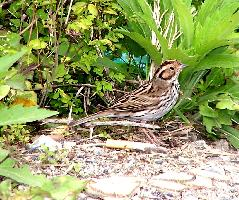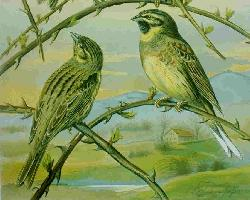
Állatleírás
The Little Bunting (Emberiza pusilla) is a captivating small passerine bird that belongs to the bunting family, Emberizidae. This species is highly admired by birdwatchers and ornithologists for its subtle yet charming plumage, intriguing migratory habits, and melodious song. Despite its modest size, the Little Bunting has a significant presence in its natural habitat, showcasing remarkable adaptations and behaviors that ensure its survival and propagation.Physical Description:
The Little Bunting is a diminutive bird, typically measuring about 12 to 14 cm in length and weighing between 12 to 18 grams. It exhibits a compact body, a rounded head, and a relatively short tail. The bill is conical and robust, perfectly designed for seed consumption, though it also includes insects in its diet, especially during the breeding season.
The plumage of the Little Bunting is a beautiful blend of browns, chestnuts, and whites, which provides excellent camouflage against the forest floor and undergrowth where it often feeds. The bird's upper parts are predominantly brown, streaked with darker shades, while the underparts are paler, usually a dull white with distinct streaks on the flanks and breast. A striking feature is its head pattern; it has a white supercilium (eyebrow), contrasting with a dark eyestripe and crown streaks, giving it a distinctive and appealing appearance. The sexes are similar in plumage, making them difficult to distinguish in the field.
Habitat and Distribution:
The Little Bunting breeds across the vast taiga and forested areas of northern Eurasia, from Scandinavia across Siberia to Far East Russia. Its preferred breeding habitats are dense undergrowth within boreal forests, often near water bodies. During the winter months, it migrates to southern Asia, frequenting scrublands, grasslands, and agricultural fields. The migration is a testament to the bird's resilience and ability to navigate across continents in search of favorable conditions.
Behavior and Diet:
Primarily a ground feeder, the Little Bunting forages for seeds, grains, and insects among the leaf litter and undergrowth. Its diet varies with the seasons; it consumes more plant material during the winter and more insects and invertebrates during the breeding season to meet the higher protein requirements for egg production and feeding chicks.
The Little Bunting is a solitary feeder but can often be found in mixed flocks during migration and in its wintering grounds. Its song is a sweet, trilling melody, often delivered from a hidden perch within dense foliage, adding an auditory charm to its forest habitat.
Reproduction:
The breeding season begins in late spring and early summer. The Little Bunting is monogamous, with pairs forming each breeding season. The female builds a well-concealed nest on the ground, using grasses and moss, where she lays 4 to 6 eggs. The eggs are incubated primarily by the female for about 11 to 14 days until hatching. Both parents are involved in feeding the altricial (helpless) chicks, which fledge approximately 8 to 12 days after hatching. The care and feeding of the young continue for some time after fledging until they are independent.
Conservation Status:
Currently, the Little Bunting is classified as Least Concern by the IUCN Red List, thanks to its vast range and stable population size. However, like many migratory species, it faces threats from habitat loss and degradation, particularly in its breeding and wintering grounds. Monitoring and conservation efforts are essential to ensure that this delightful bird continues to grace the forests and fields of Eurasia with its presence.
In summary, the Little Bunting is a remarkable avian species that adds to the biodiversity of the ecosystems it inhabits. Its resilience in the face of seasonal changes, the beauty of its plumage, and its melodious song make it a fascinating subject of study and admiration for bird enthusiasts and conservationists alike.
Hasonló állatok
Új állatfotók
Top 10 állat
- Dolphin gull (Leucophaeus scoresbii)
- Japanese macaque (Macaca fuscata)
- Stone loach (Barbatula barbatula)
- Russian tortoise (Testudo horsfieldii)
- Galápagos tortoise (Geochelone nigra complex)
- Greek tortoise (Testudo graeca)
- Diana monkey (Cercopithecus diana)
- Common flying dragon (Draco volans)
- Moustached guenon (Cercopithecus cephus)
- Galápagos penguin (Spheniscus mendiculus)


